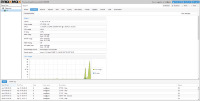Nikki
New Member
From https://www.proxmox.com/en/news/press-releases/proxmox-ve-4-2-released
So we get:
Here's what the new interface looks like (Ignore the outdated kernel, I haven't rebooted it yet)

The new Sencha Ext JS 6 framework brings a modern 'flat design' look and feel to the Proxmox VE GUI with a reworked icon set providing consistency and an optimal user experience. In the 'Summary View' data information is now visualized in graphs which gives the user an overview of all his performance data. Browser variations are handled automatically so that the charts always display correctly. The graphs provide enhanced interactive features such as click zoom. With the new Ext JS framework more settings moved from the command line to the GUI such as LXC mount point options or syslog date filtering. Translations for French, German, Italian, and Norwegian were updated within the new GUI, which is translated into 19 languages in total.
New LVM-thin and ZFS improvements help increase storage utilization
Proxmox VE is a bare-metal ISO installer, based on latest Debian Jessie 8.4 combined with a long term Linux 4.4 kernel, based on Ubuntu 16.04 LTS (Xenial Xerus). With Proxmox VE 4.2 logical volumes can now be thin provisioned and therefore the Proxmox bare-metal ISO installer offers LVM-thin or ZFS with just one click. A storage administrator can dedicate more capacity to virtual machines than they have and create logical volumes that are larger than the available extents. This ability offers great flexibility and can be expanded dynamically when needed and can help avoiding the need to purchase additional storage because of unused, over-allocated storage.
Another new feature is that ZFS storage can now be selected during the installation process. If the admin chooses ZFS, the ZFS-Plugin will be automatically configured out-of-the-box and the user does not have to re-configure it later.
New SSL certificates with “Let's Encrypt”
Proxmox VE 4.2 now works with the free web server certificates from “Let’s Encrypt”. “Let’s Encrypt” is a free, automated, and open certificate authority providing free SSL certificates with short expiry and automated renewal. This significantly simplifies the process of getting and maintaining a certificate for secure websites with simple commands. The objective of “Let’s Encrypt” and the ACME protocol is to make it possible to set up an HTTPS server and have it automatically obtain a browser-trusted certificate, without any human intervention. This is accomplished by running a certificate management agent on the web server.
So we get:
- GUI update to Sencha Ext JS 6, including new icon set and dynamic performance charts
- based on Debian Jessie 8.4.0
- Linux kernel 4.4.6
- KVM/qemu 2.5.1
- installer: LVM thin or ZFS plugin pre-configured
- LVM thin support
- Let´s Encrypt support (Not in the GUI yet, unfortunately)
- DRBD9: drbd 9.0.2 kernel module and drbdmanage 0.95
- LXC: improved container setup
- LXC: network rate limits
- LXC: adding mount-points via GUI
- LXC: pct can mount rootfs for read/write access of stopped or running containers
- LXC: backup/snapshot improvements, including proper backup and restore of ACL
- LXC: add support for Alpine Linux, Ubuntu 16.04
- HA manager improvements
- new confirmation dialog to prevent accidentally removal of a virtual machine or container
- updated GUI translation (especially French, Italian and German)
- many new and improved manual pages
- countless bug fixes and package updates (for all details see bugtracker and GIT)
Here's what the new interface looks like (Ignore the outdated kernel, I haven't rebooted it yet)

Last edited by a moderator:
